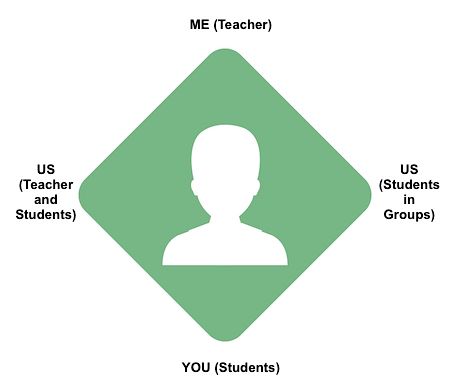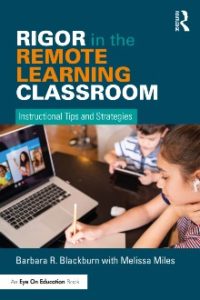Using Gradual Release in Remote Learning
By Barbara R. Blackburn
It’s important for teachers to keep in mind that we need to give students support at an appropriate level throughout the learning process, whether we’re teaching face to face, completely online, or in a hybrid model.
At the beginning of new learning, more support is always needed. However, as the learning continues, we want students to become more independent in their learning. This is called gradual release, and it is especially important when we’re working with students in remote learning situations.
Since we are not physically available at all times, we need to readjust our thinking about how best to gradually pull away our instructional scaffolding and give students more ownership of the learning process.
Gradual Release Model
One way to think about scaffolding using gradual release is with a diamond or rhombus visual organizer. As you can see from the figure below, it starts with ME (meaning the teacher). You begin by modeling a lesson. This might happen during a live lesson, or you might create a slide show or video recording that students can refer to regularly.

The second part of guided practice is US (Students in Groups) with your students working with a single partner or in small groups. Here, you’ll ideally use chat threads or breakout rooms so students can work together at the same time.
As a second option, you might use some type of tool with asynchronous messaging capacity – a Flipgrid video or sticky notes inside the Google Jamboard app are two of many options that might come to mind. Asynchronicity is not ideal, since students are working back and forth on their own timelines, but we sometimes have to adapt to our circumstances.
Finally, as the diagram shows, YOU (the student) does the work independently, which can happen in a variety of remote formats.
Pacing the release
How do you decide when to move a student through the various stages of gradual release? I wish I could give you a set formula, but there isn’t one. Sometimes students need to see you model something once; other students may need multiple explanations and models.
Capitalizing on technology can be helpful. For example, you might record your live presentation, and also provide another video or set of directions to help students understand the learning practice process if they get stuck.
Also, while observing their group or paired work, use formative assessment strategies to help you know when they are ready to work on their own. For example, when teaching students how to complete research, it’s important to use a platform that allows you to share your screen and record yourself thinking aloud as you look for credible, relevant sites using various key word searches.
Another example might have you modeling how to take the research gathered, organize it, and paraphrase the information (or directly quote it) – all while talking through the process with students as you make decisions to build your paragraph from research.
It doesn’t have to be anything fancy; students need to see that rough drafts are messy and that they take much time and thought.
Sample Lesson
Let’s look at a sample math lesson on ratios adapted for the remote setting. To begin the lesson, I’m going to ask students to post something they know about ratios on Class Dojo. Then, students watch a prerecorded video of information about ratios, in which we focus on ME, the teacher presenting a lesson.

To move to the second portion of the US phase (partners and small groups), the teacher moves students into breakout spaces to solve additional problems. As the class regroups, the teacher answers questions and provides information on the independent work students are to complete (the YOU section of the lesson).
Independent work is submitted to the teacher based on your preferences, whether students post it in a learning platform or email it directly to you. One way I prefer is for students to video themselves explaining how they solved a problem, posting it on Flipgrid or a similar app for your feedback and/or that of other students.
A Final Note
For many years, teachers have used the gradual release model as a core element of their teaching practice – shifting ownership and responsibility by degrees from themselves to students in a way that provides scaffolding for success.
In a remote setting, gradual release of responsibility is often even more important, as students need structure to learn – often alone and at a distance.

A nationally recognized expert in the areas of rigor and motivation, she collaborates with schools and districts for professional development. Barbara can be reached through her website or her blog. Follow her on Twitter @BarbBlackburn.
































What time frame was used?